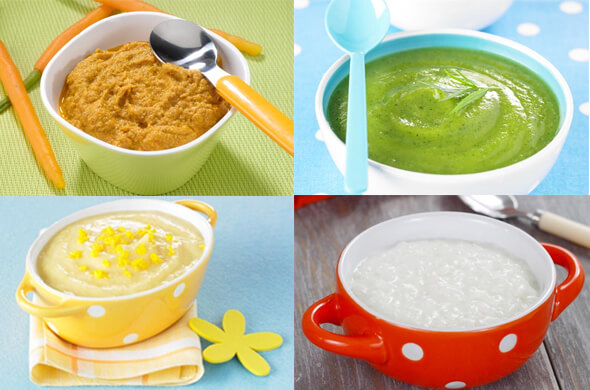
INTRODUCING SOLID FOODS:
As I have mentioned in my previous blog (No to Soild Food before 6 Months) transition to solid foods are appropriate after 6 months of age. I have tried to address some of the common questions families ask me about how to introduce solid foods.
WHAT SHOULD YOU START WITH AND HOW MUCH?
- Rice cereal is a good first choice. It is easily digested and very few people are allergic to it
- Begin with 1-2tsp of cereal mixed with water, breast mild or formula
- When the baby is comfortable, you can thicken the mixture and begin to feed the same 2-3 times a day
- Resist the urge to feed the cereal from a bottle. Instead help your baby sit upright and offer the cereal with a small spoon once or twice a day
- Use single ingredient foods
- Gradually introduce pureed fruits, vegetables and other new foods one at a time
- Allow 3-5 days before introducing new foods. This gives the baby time to adjust to each new food. If there is a reaction, it is easier to tell which food caused it
- Look for allergic reactions like skin rashes, wheezing, diarrhoea, vomiting, abdominal pains
IS THRE ANYTHING THAT ONE SHOULD AVOID?
There are some foods which should not be given to the baby till he/she is one year of age. Foods like cow’s milk, egg, shell fish and nuts should not be offered to the baby as they may trigger an allergic reaction. Honey should not be given as they may grow spores in the intestines causing a serious condition call botulism
SIXTH MONTH ONWARDS
- Fresh diluted fruit juices should be introduced
- Strained clear vegetable soups
- Boiled and mashed carrot/potato
- Mashed banana
- Stewed apple
- Cereal-pulse mixtures with boiled or steamed vegetables may be given
- Teething process begins at this period; pieces of toasted bread, carrot, chapatti may be given to nibble
EXAMPLE
- Cereal-pulses mixtures:
- Rice/wheat flour/ragi/sooji/puffed rice/broken wheat with Bengal gram dhal/ green gram dhal
- Boiled or steamed green leafy vegetable, carrots, peas and beans, gourds, potatoes etc
- Egg yolk in full boiled form
NINE TO ELEVEN MONTHS
Wholesome cereal pulse meals may be introduced with gradual inclusion of other foods
- Kichidi
- Rice/chapattis with dhal, vegetables, curds
- Bread/idly with paneer, eggs, chicken
- Fruit juices (without dilatation)
TWELVE TO SIXTEEN MONTHS
- The child can now eat the same food as prepared for the rest of the family without spices and excess fat. The food may still need to be softened slightly
A LIST OF FOODS RICH IN VARIOUS NUTRIENTS ARE GIVEN BELOW. CHOOSE FROM THEM DEPENDING ON THE AGE OF YOUR CHILD
- Mild and milk products such as curd, chesese (limited) paneer, ice creams
- Animal product such as eggs, meat, fish and chicken
- Dhal and grams of all kinds rajmah, channa, soyabeans (etc)
- Foods containing mainly energy – butter, margarine, honey, jam, sugar, jiggery , marmalade, cream
- Try a few fried foods and snacks if the child is old enough to be able to digest them. Remember, they should not be salty
- Add butter or ghee to rice, dhal etc
- Add paneer, minced meat or fish to rice or karji’s to add proteins
TIPS FOR MAKING THE BABY’S MEAL TIME ENJOYABLE
- Introduce new foods one by one
- Babies tolerate bland foods rather than spicy foods
- Give the baby food at moderate temperature
- Foods should be given in small quantities at frequent intervals as the baby’s stomach capacity is small
- Encourage the baby to attempt feeding him or herself
Dr. Chitra Sankar Developemntal Pediatrician
